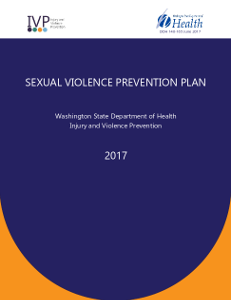Medium
Topic
- Planning
- Strategies
2017 Sexual Violence Prevention Plan
We are pleased to present the "2017 Sexual Violence Prevention Plan," an update to the "2009 Sexual Violence Prevention Plan, Synergies." The period surrounding the development of the 2009 plan was the culmination of a shift in statewide focus away from risk reduction efforts, and toward perpetration reduction. The 2017 plan builds upon that transition. It emphasizes community-driven decision-making and encourages efforts to track and evaluate programs, which promote evidence-informed applications of prevention work statewide. Additionally, while Washington State pursues many ways to create a world free of sexual violence, this plan focuses on primary prevention.
Leading this effort is the Washington State Department of Health, in partnership with the Department of Commerce's Office of Crime Victims Advocacy and the Washington Coalition of Sexual Assault Programs. These three organizations make up the Prevention Steering Committee (PSC).
Guiding Principles of Prevention
The Prevention Steering Committee (PSC), through a facilitated process, identified six principles that will guide statewide efforts to prevent sexual violence over the next five years. These guiding principles are the values that inspire the goals, strategies, and action steps identified in this plan.
- Comprehensive prevention programming
- Community-led and culturally specific prevention
- Sustainable prevention efforts
- Commitment to continuous improvement
- Intersectional approaches
- Trauma-informed approaches
Prevention Goals
These goals provide strategic direction over the next five years, focusing the collective efforts of the many individuals and organizations working toward sexual violence prevention in our state.
Please see the full Prevention Plan to read the accompanying rationale and targeted action steps for both the state and local levels for each goal.
- Support the individuals, groups, and organizations that engage in building skills and shifting norms to prevent sexual violence.
- Implement comprehensive prevention strategies that address the culture of perpetration.
- Expand comprehensive prevention programming across the state.
- Continue to develop and enhance evaluation of sexual violence prevention programming.
- Increase utilization of state-level data.
